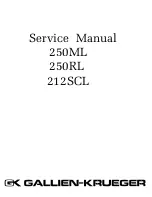
ENGLISH
5
FACILITIES AND CONTROLS
POWER (switch)
- Turns the unit on. We recommend that the unit be powered
up before connecting to any equipment that it is feeding, to avoid clicks or thumps
which may harm output devices. It is also a good idea to allow the unit to stabilise for
a couple of minutes before use to ensure that the internal circuitry is properly
initialised.
DISCRETE CLASS A PRE-AMP
This part of the unit is a pre-amplifier, used to amplify the incoming signal being fed
to the MIC INPUT or INSTRUMENT INPUT to a suitable level before any further
processing is applied.
MIC INPUT
- This is an XLR connector that allows you to connect a microphone
to the unit. There is also a MIC INPUT XLR on the rear panel, but only one may be
used at a time; do not connect both MIC INPUTs simultaneously. If using the
VoiceMaster Pro’s mic pre and feeding the output into a mixing console, bypass the
console’s own mic pre and connect to the channel’s line input. This will mean the
superior VoiceMaster Pro mic pre is used to route signal to its destination, e.g. a
recording device, avoiding unwanted distortion and colouration from an inferior mic
pre. Always avoid routing the VoiceMaster Pro’s mic pre into a second mic pre, as this
will produce greatly inferior results.
+48V (switch)
- This pr48V of phantom power for condenser
microphones (affecting the MIC INPUT only.) If you are unsure whether your
microphone requires phantom power, refer to its user guide before connecting, as it is
possible to damage some microphones (most notably ribbon microphones) by
providing them with phantom power.
INSTRUMENT INPUT
- This is a high impedance 1/4" jack input that allows
you to connect an electric guitar or bass guitar to the unit without loading the pickups,
and without the need for a DI box. If both the mic and instrument inputs are
connected, the instrument input will override the mic input.
Ø (Phase Reverse switch)
- This allows the phase of the input signal to be
reversed e.g. to correct phase problems when incorrect wiring polarity has occurred.
LINE (switch)
- When engaged (in), this switch selects the rear panel LINE
INPUT, and an LED is illuminated in the switch cap to indicate that the LINE
INPUT is active. If this is disengaged (out), the MIC INPUT and INSTRUMENT
INPUT are active.
(HPF knob and switch)
- This is a high-pass filter, which removes
unwanted low frequencies such as stage rumble via microphone stands, or 'proximity
effect' (where low frequencies are over-emphasised when using certain types of
microphone at close range). The knob sets the cut-off frequency (from 30 to 400 Hz,
18 dB per octave), and the switch must be engaged (in) for the control to function.
INPUT GAIN (knob)
- This is used to set the optimum input signal level.
Connect an input signal to the unit, ensuring that the INPUT GAIN control is set
fully counter-clockwise, and increase the INPUT GAIN control whilst observing the
LED signal meter. The red O/L (overload) LED may light occasionally, but only if the
input signal gets particularly loud. If the O/L LED stays on continuously for any
period, or you hear the unit distort during loud peaks, you should reduce the INPUT
GAIN.
Note that the meter is calibrated to read 0 dBfs at the top of the meter- this has been
set up to enable simple metering when recording to digital media. The best level to set
for recording depends on your recording medium. If recording to an analogue
medium like tape, where extra headroom is required, a level of –18 dBfs will give a
su4 dBu equivalent output. If recording to digital media, you may wish to
record at a higher level, peaking at e.g. –4 to –6 dBfs. Confused? Visit
www.sospubs.co.uk/sos/may00/articles/digital.htm for further illumination.
With the MIC INPUT selected, the INPUT GAIN control provides 0 dB (fully
counter-clockwise) to +60 dB (fully clockwise) of gain. With the INSTRUMENT
INPUT selected, the INPUT GAIN control pr4 dB to +34 dB of gain. With
Summary of Contents for VoiceMaster Pro
Page 87: ...87 NOTES ...
Page 88: ...88 NOTES ...






































